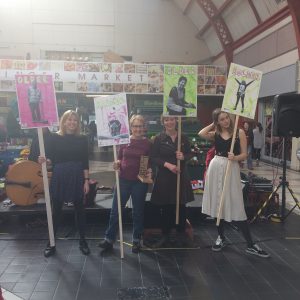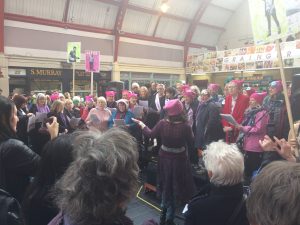How can existing stereotypes relating to age and gender be positively challenged? Here Professor Karen Ross explains how her latest ESRC IAA funded project engaged the whole community in challenging traditional representations of women in the media.
I have been researching the relationship between gender and media for more than 20 years and as I was presenting the findings from my latest study last year I thought, hang on, we know all this, we have known all this for years, about the marginalisation and invisibilising (yes, I have just made that up but it absolutely fits my point) of women from the mediated public sphere, why not do something about it?! So the idea for a community engagement project where older women would be visible and vocal was born.
The ESRC IAA funded project has had three aspects, digital storytelling, photography and public event. I began by designing a short statement of my ambitions for the project and asking for participants among local women who identified with being ‘older’. I sent the statement to a variety of community projects, networks of older people, organisations working with and for older people and it was further cascaded via a variety of different friendship groups, personal contacts and word of mouth. In the end, 16 women took part in the first phase (digital story-telling) and I ran three workshops in November and December 2016, facilitated by the brilliant Alex Henry and her team at Curiosity Creative. The resulting digital stories can be found here.
Fifteen of those women then agreed to take part in the second part of the project which was to be photographed at a place which either had a special meaning for them or else somehow ‘represented’ who they are. The last phase of the project was a public engagement activity which started life as a catwalk show but eventually became a Flashmob/pop-up choir, such is the way of consultation. This was a spectacularly successful event which took place on International Women’s Day, with groups of students from Newcastle University, Heaton Manor School, Gosforth Academy and Gateshead College covering the event from all angles, interviewing participants and shoppers and doing a brilliant job on social media. See here for a glimpse of what we got up to. At a conservative estimate, around 70 local women took part in the event and I have received some heartfelt thanks from participants for whom the event was the first time they said they felt part of something important.
For someone who likes to be in control, working with members of the public is a highly rewarding but very challenging enterprise because they can be unruly, unpredictable and unreliable as well as brilliant, bold and brave. But the plus point of actually doing something meaningful in the lives of people other than one’s own academic peers and the few random PhD students who together comprise the handful of folks who will ever read our scholarly exegesis, entirely overshadows the small irritations of poor time-keeping and loss of attention.
The photographic exhibition is up on the first floor of the City Library, from 9-22 March, so do go along and catch it if you can. The photos on display, taken by Donna-Lisa Healy, show the strength, resilience and humour of women and are accompanied by their digital stories which can be heard as the visitor walks around the exhibition. They were also displayed on the big screen at the top of Northumberland Street on International Women’s Day and the women who saw themselves in giant form were both bemused and tickled pink: I hope you are too.


